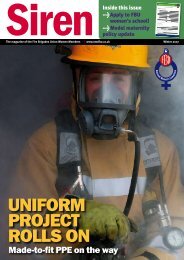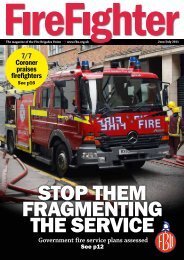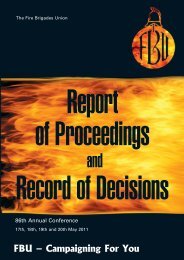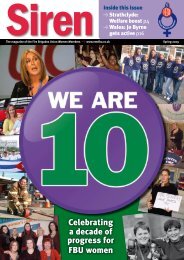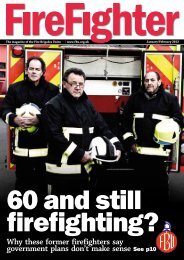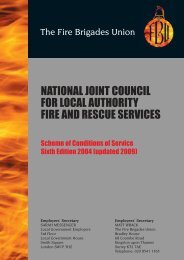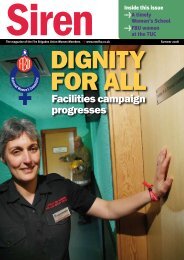Report - Fire Brigades Union
Report - Fire Brigades Union
Report - Fire Brigades Union
Create successful ePaper yourself
Turn your PDF publications into a flip-book with our unique Google optimized e-Paper software.
SECTION B — FIRE AND RESCUE SERVICE POLICY<br />
3.7.2. That the access defect rectification plan is<br />
implemented by CLG.<br />
3.7.3. That the local authority controlled companies<br />
designate the rooms to be used as meeting and<br />
training rooms and consider either installing<br />
permanent inductive loop systems in those rooms,<br />
or purchasing a portable inductive loop and<br />
establishing an effective management system for it.<br />
General<br />
We believe that all recommendations in the Equality<br />
Impact Assessment should be implemented.<br />
Further we believe that CLG should make the staff<br />
retention model (other than in London) mandatory on all<br />
FRAs and respective LACCs.<br />
That out-standing EIAs required to be conducted by LACCs<br />
should be carried out as a matter of urgency.<br />
Information provided by the <strong>Fire</strong> <strong>Brigades</strong> <strong>Union</strong> to<br />
CLG Select Committee<br />
25 February 2010<br />
Specific Examples of End User Requirements not being<br />
met by FiReControl<br />
4. CLG Staffing Model and associated staffing matters<br />
A. Staffing Numbers<br />
CLG’s position from the outset has been that as they<br />
are not the employing body nor the service provider<br />
that it is the LACCs who will make the decisions on<br />
staffing numbers. This is reflected in the Part 1 and<br />
Part 2 Final Business Cases.<br />
CLG have though produced baseline staff numbers<br />
which are produced according to its staffing model which<br />
they have proposed to LACCs. These are contained in<br />
the Part 2 Business Case, and are shown below:<br />
Current<br />
Region Transitional Steady figure (all local)<br />
figure figure controls in<br />
LACC region)<br />
West Midlands ?* 70 159<br />
NE 63 55 110<br />
Yorkshire and<br />
Humberside 75 71 142<br />
SW 72 63 176.5<br />
East Midlands 70 56 141<br />
SE 85 75 227 **<br />
London 92 81 125 est<br />
NW 96 84 187<br />
East of England 83 63 148 **<br />
Total 636 618 1415.5<br />
* No figure given in Part 2 Business Case<br />
** No figure given in Part 2 Business Case, figures<br />
provided from other sources – watch based staff<br />
numbers only – managerial and other staff to be<br />
added<br />
The FBU believes the numbers of staff on duty across<br />
the network is dangerously low and therefore the call<br />
handling capacity of RCCs will be much reduced from<br />
current levels and are the result of hypothetical<br />
modelling.<br />
The project relies heavily on IT and we are constantly<br />
told that control operators in any RCC will be able to<br />
answer a call from anywhere in the country. However,<br />
due to the seriously low indicative staffing numbers<br />
suggested by the CLG staffing model the system<br />
would reach saturation point very quickly and not be<br />
able to cope. Since the IT is only of any use at all<br />
when it can be answered quickly and interpreted by a<br />
control operator we believe end user requirements<br />
will not be met. For example the CLG have no power<br />
over the LACCs to set minimum crewing levels thus<br />
ensuring resilient staffing numbers across the<br />
network.<br />
It will be down to each individual RCC to decide how<br />
many staff they wish to have on duty at any one time,<br />
they could rely on the rest of the network to answer<br />
their calls, but if they all do this then the result will be<br />
overload and calls going unanswered.<br />
B. Staffing Numbers – beyond their sell-by date<br />
On 15 July 2009, the fire minister announced the latest<br />
delay. That same day CLG also announced the<br />
introduction of Solution Establishment Workshops in<br />
order to discuss end user problems/ perspective/<br />
requirements:<br />
“The Minister also explained improvements to the<br />
project approach. Joint CLG and EADS (the main<br />
contractor) teams would be working on a day-today<br />
basis with the <strong>Fire</strong> and Rescue Service. A<br />
series of Solution Establishment Workshops have<br />
started at EADS, involving the CLG team, FRS<br />
representatives and EADS.”<br />
(Source: FRS Circular 43/2009)<br />
The staffing model was rolled out in April 2008. The<br />
staffing numbers were proposed to LACCs in July<br />
2008 [they were included in the Part 2 (regional)<br />
Business Cases]. The Solution Establishment<br />
Workshops did not commence until August 2009 and<br />
are still not finished.<br />
The staffing numbers (and staffing model) will need to<br />
be re-visited once the outcomes of the Workshops<br />
have been finalised. It is the view of the FBU that CLG<br />
should acknowledge this fact and make an<br />
announcement to that effect.<br />
C. Audit, assessment and regulation of adequacy of<br />
staffing arrangements for national assurance.<br />
CLG maintains that resilience will be assured because<br />
of the performance standards that the LACCs will be<br />
required to meet and the existence of the contractual<br />
requirements of the LACC.<br />
FBU Annual <strong>Report</strong> 2011 75





